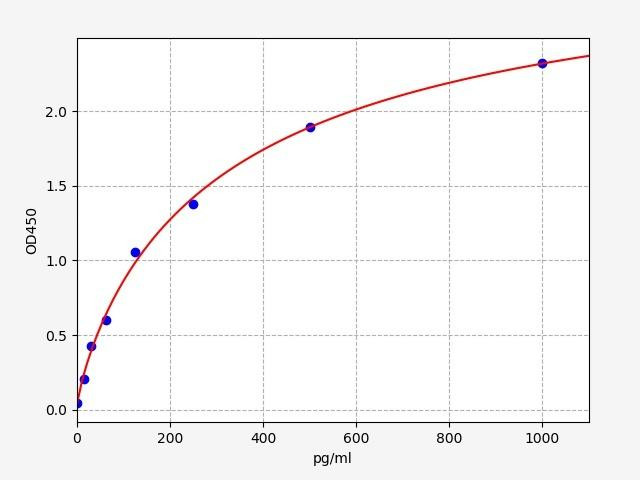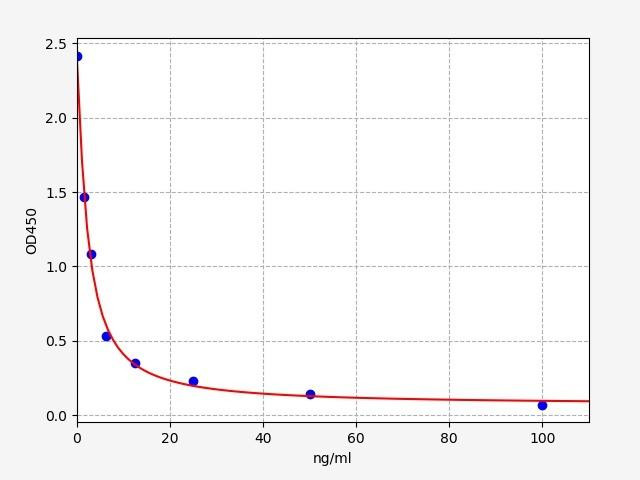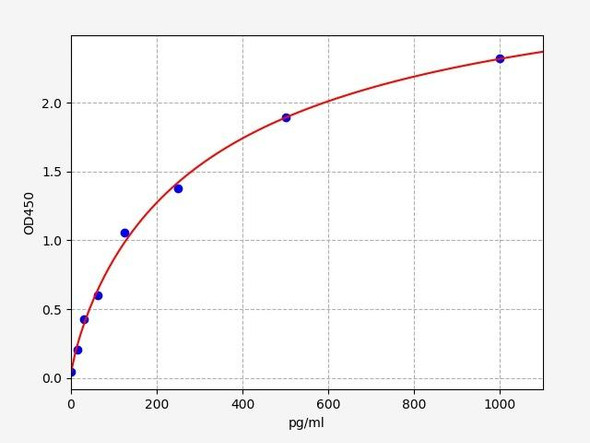Serotonin ELISA Kit
- SKU:
- UNFI0018
- Product Type:
- ELISA Kit
- Size:
- 96 Assays
- Sensitivity:
- 0.938ng/ml
- Range:
- 1.563-100ng/ml
- ELISA Type:
- Competitive
- Synonyms:
- ST, 5-HT, Serotonin, 5-Hydroxytryptamine
- Reactivity:
- Universal
Description
Serotonin ELISA Kit
Serotonin is a neurotransmitter and hormone that plays a crucial role in regulating mood, sleep, appetite, and various other physiological processes in the body. It is involved in numerous biological functions and is often implicated in psychiatric and neurological disorders. The Serotonin ELISA Kit is specifically designed to measure serotonin levels in biological samples, allowing researchers to accurately quantify and analyze serotonin concentrations, facilitating a better understanding of its functions and associated conditions.
Key Features
| Save Time | Pre-coated 96 well plate | |
| Quick Start | Kit includes all necessary reagents | |
| Publication Ready | Reproducible and reliable results |
Overview
| Product Name: | ST/5-HT (5-hydroxytryptamine) ELISA Kit |
| Product Code: | UNFI0018 |
| Size: | 96 Assays |
| Alias: | ST, 5-HT, Serotonin, 5-Hydroxytryptamine |
| Detection Method: | Competitive ELISA, Coated with Antibody |
| Reactivity: | Universal |
| Sensitivity: | 0.938ng/ml |
| Range: | 1.563-100ng/ml |
| Storage: | 4°C for 6 months |
| Note: | For Research Use Only |
Additional Information
| Recovery | Matrices listed below were spiked with certain level of ST/5-HT and the recovery rates were calculated by comparing the measured value to the expected amount of ST/5-HT in samples.
| ||||||||||||||||||||
| Linearity: | The linearity of the kit was assayed by testing samples spiked with appropriate concentration of ST/5-HT and their serial dilutions. The results were demonstrated by the percentage of calculated concentration to the expected.
| ||||||||||||||||||||
| CV(%) | Intra Assay <8 Inter Assay <10 |
Kit Components
| Component | Quantity | Storage |
| ELISA Microplate (Dismountable) | 8x12 strips | 2-8°C/-20°C |
| Lyophilized Standard | 2 | 2-8°C/-20°C |
| Sample/Standard Dlution Buffer | 20ml | 2-8°C |
| Biotin-labeled Antibody (Concentrated) | 120ul | 2-8°C (Avoid Direct Light) |
| Antibody Dilution Buffer | 10ml | 2-8°C |
| HRP-Streptavidin Conjugate (SABC) | 120ul | 2-8°C (Avoid Direct Light) |
| SABC Dilution Buffer | 10ml | 2-8°C |
| TMB Substrate | 10ml | 2-8°C (Avoid Direct Light) |
| Stop Solution | 10ml | 2-8°C |
| Wash Buffer (25X) | 30ml | 2-8°C |
| Plate Sealer | 5 | - |
Other materials required:
- Microplate reader with 450 nm wavelength filter
- Multichannel Pipette, Pipette, microcentrifuge tubes and disposable pipette tips
- Incubator
- Deionized or distilled water
- Absorbent paper
- Buffer resevoir
Protocol
*Note: Protocols are specific to each batch/lot. For the correct instructions please follow the protocol included in your kit.
Equilibrate the TMB substrate for at least 30 min at 37°C beforeuse. When diluting samples and reagents, they must be mixed completely andevenly. It is recommended to plot a standard curve for each test.
| Step | Procedure |
| 1. | Set standard, test sample and control (zero) wells on the pre-coatedplate respectively, and then, record their positions. It isrecommended to measure each standard and sample in duplicate. Washplate 2 times before adding standard, sample and control (zero) wells! |
| 2. | Add Sample and Biotin-detection antibody: Add 50µL of Standard, Blank or Sample per well. The blankwell is added with Sample Dilution Buffer. Immediately add 50 µL of biotin-labelled antibody workingsolution to each well. Cover with the plate sealer provided. Gently tap the plate to ensure thoroughmixing. Incubate for 45 minutes at 37°C. (Solutions are added to the bottom of micro-ELISA platewell, avoid touching plate walls and foaming). |
| 3. | Wash: Aspirate each well and wash, repeating the process three timesWash by filling each well with Wash Buffer (approximately 350µL)using a squirt bottle, multi-channel pipette, manifold dispenser orautomated washer. Complete removal of liquid at each step is essentialto good performance. After the last wash, remove any remaining WashBuffer by aspirating or decanting. Invert the plate and pat it againstthick clean absorbent paper. |
| 4. | HRP-Streptavidin Conjugate(SABC): Add 100µL of SABC workingsolution to each well. Cover with a new Plate sealer. Incubate for30minutes at 37°C. |
| 5. | Wash: Repeat the aspiration/wash process for five times. |
| 6. | TMB Substrate: Add 90µL of TMB Substrate to each well. Coverwith a new Plate sealer. Incubate for about 10-20 minutes at 37°C.Protect from light. The reaction time can be shortened or extendedaccording to the actual color change, but not more than 30minutes.When apparent gradient appeared in standard wells, you can terminatethe reaction. |
| 7. | Stop: Add 50µL of Stop Solution to each well. Color turn toyellow immediately. The adding order of stop solution should be as thesame as the substrate solution. |
| 8. | OD Measurement: Determine the optical density (OD Value) of each wellat once, using a microplate reader set to 450 nm. You should open themicroplate reader ahead, preheat the instrument, and set the testing parameters. |
Sample Preparation
When carrying out an ELISA assay it is important to prepare your samples in order to achieve the best possible results. Below we have a list of procedures for the preparation of samples for different sample types.
| Sample Type | Protocol |
| Serum | If using serum separator tubes, allow samples to clot for 30 minutes at room temperature. Centrifuge for 10 minutes at 1,000x g. Collect the serum fraction and assay promptly or aliquot and store the samples at -80°C. Avoid multiple freeze-thaw cycles. If serum separator tubes are not being used, allow samples to clot overnight at 2-8°C. Centrifuge for 10 minutes at 1,000x g. Remove serum and assay promptly or aliquot and store the samples at -80°C. Avoid multiple freeze-thaw cycles. |
| Plasma | Collect plasma using EDTA or heparin as an anticoagulant. Centrifuge samples at 4°C for 15 mins at 1000 × g within 30 mins of collection. Collect the plasma fraction and assay promptly or aliquot and store the samples at -80°C. Avoid multiple freeze-thaw cycles. Note: Over haemolysed samples are not suitable for use with this kit. |
| Urine & Cerebrospinal Fluid | Collect the urine (mid-stream) in a sterile container, centrifuge for 20 mins at 2000-3000 rpm. Remove supernatant and assay immediately. If any precipitation is detected, repeat the centrifugation step. A similar protocol can be used for cerebrospinal fluid. |
| Cell culture supernatant | Collect the cell culture media by pipette, followed by centrifugation at 4°C for 20 mins at 1500 rpm. Collect the clear supernatant and assay immediately. |
| Cell lysates | Solubilize cells in lysis buffer and allow to sit on ice for 30 minutes. Centrifuge tubes at 14,000 x g for 5 minutes to remove insoluble material. Aliquot the supernatant into a new tube and discard the remaining whole cell extract. Quantify total protein concentration using a total protein assay. Assay immediately or aliquot and store at ≤ -20 °C. |
| Tissue homogenates | The preparation of tissue homogenates will vary depending upon tissue type. Rinse tissue with 1X PBS to remove excess blood & homogenize in 20ml of 1X PBS (including protease inhibitors) and store overnight at ≤ -20°C. Two freeze-thaw cycles are required to break the cell membranes. To further disrupt the cell membranes you can sonicate the samples. Centrifuge homogenates for 5 mins at 5000xg. Remove the supernatant and assay immediately or aliquot and store at -20°C or -80°C. |
| Tissue lysates | Rinse tissue with PBS, cut into 1-2 mm pieces, and homogenize with a tissue homogenizer in PBS. Add an equal volume of RIPA buffer containing protease inhibitors and lyse tissues at room temperature for 30 minutes with gentle agitation. Centrifuge to remove debris. Quantify total protein concentration using a total protein assay. Assay immediately or aliquot and store at ≤ -20 °C |
| Breast Milk | Collect milk samples and centrifuge at 10,000 x g for 60 min at 4°C. Aliquot the supernatant and assay. For long term use, store samples at -80°C. Minimize freeze/thaw cycles. |
Serotonin Background
Serotonin Molecule
Serotonin, also known as 5-hydroxytryptamine (5-HT), is a neurotransmitter and hormone that plays a critical role in the central nervous system (CNS) and the periphery. It is primarily synthesized and stored in the specialized neurons known as serotonergic neurons, which are located in the brainstem and certain regions of the gastrointestinal tract.
Serotonin Chemical Structure
Serotonin is a monoamine neurotransmitter and belongs to the class of indoleamines. Chemically, it consists of an indole ring, an ethylamine side chain, and a hydroxyl group. This structure is crucial for its interaction with serotonin receptors and its ability to transmit signals within the nervous system.
Serotonin Function
Serotonin has diverse functions throughout the body. In the CNS, it acts as a neurotransmitter and is involved in regulating mood, sleep, appetite, aggression, pain perception, and body temperature. Serotonin also plays a role in cognition and memory processes. In the periphery, it exerts various effects on the cardiovascular, gastrointestinal, and respiratory systems.
Serotonin Metabolism
Serotonin Synthesis
Serotonin synthesis begins with the amino acid tryptophan. Tryptophan is obtained from the diet and transported into the brain. Inside serotonergic neurons, tryptophan is converted into 5-hydroxytryptophan (5-HTP) by the enzyme tryptophan hydroxylase (TPH). TPH is the rate-limiting enzyme in serotonin synthesis and is regulated by various factors, including feedback inhibition by serotonin itself. 5-HTP is then further converted into serotonin by the enzyme aromatic L-amino acid decarboxylase (AADC).
Serotonin Reuptake
Once serotonin is released from serotonergic neurons into the synaptic cleft, it can bind to specific receptors on the postsynaptic neuron to transmit signals. To terminate its activity, serotonin is actively transported back into the presynaptic neuron through a serotonin transporter (SERT), also known as the reuptake pump. The reuptake process allows for the recycling of serotonin and is essential for maintaining proper neurotransmission.
Serotonin Degradation
Serotonin can be metabolized and degraded by the enzyme monoamine oxidase (MAO) to produce an inactive metabolite called 5-hydroxyindoleacetic acid (5-HIAA). MAO is found in various tissues, including the liver and neurons. The breakdown of serotonin by MAO occurs primarily in the liver. 5-HIAA is then excreted in the urine.
Serotonin Clinical Significance
Serotonin dysregulation has been implicated in several psychiatric and neurological disorders.
Low Levels - Serotonin and anxiety
Low Serotonin levels have been associated with a numbers of disorders - including insomnia, depression and anxiety disorders.
Low levels of serotonin have been associated with an increased risk of developing anxiety disorders. Serotonin helps regulate the activity of circuits in the brain involved in anxiety, such as the amygdala, which is responsible for processing fear and stress responses. Insufficient serotonin signaling in these circuits can lead to an overactive fear response and an increased vulnerability to anxiety.
Serotonin Agonists
Serotonin agonists, also known as serotonergic agonists or serotonin receptor agonists, are a class of pharmacological compounds that bind to and activate specific serotonin receptors in the central nervous system and peripheral tissues. These agonists mimic or enhance the effects of serotonin,
Selective serotonin reuptake inhibitors (SSRIs), a class of antidepressant medications, are commonly prescribed to treat anxiety disorders. SSRIs work by increasing the concentration of serotonin in the synaptic cleft, the gap between neurons, which enhances serotonin signaling. By doing so, SSRIs can help alleviate symptoms of anxiety by regulating the balance of neurotransmitters involved in mood regulation. Furthermore, serotonin receptors, particularly the 5-HT1A receptor subtype, are targets for anxiolytic medications. Activation of these receptors can produce anxiolytic effects, reducing anxiety levels. Drugs that directly target these receptors, such as buspirone, are sometimes prescribed for anxiety disorders.
Elevated Serotinin Levels
Elevated serotonin levels, also known as serotonin excess or hyperactivity, can occur due to various factors such as certain medical conditions, medication interactions, or rare genetic disorders. When serotonin levels are excessively high, it can lead to a condition called serotonin syndrome, which is characterized by a range of symptoms including agitation, confusion, rapid heart rate, dilated pupils, high blood pressure, tremors, and in severe cases, it can be life-threatening.
Serotonin antagonists
Serotonin antagonists are pharmacological compounds that block specific serotonin receptors in the central nervous system and peripheral tissues. By inhibiting serotonin's binding and activation of these receptors, antagonists interfere with serotonergic signaling. They can selectively target different receptor subtypes, such as 5-HT1, 5-HT2, and 5-HT3. Serotonin antagonists are used for various therapeutic purposes, such as managing chemotherapy-induced nausea and vomiting (5-HT3 antagonists) or treating psychiatric disorders like schizophrenia (5-HT2A antagonists). These compounds have potential side effects and should be used under medical supervision.
Citations
| Hassan et al. | Olive Leaf Extract Attenuates Chlorpyrifos-Induced Neuro-and Reproductive Toxicity in Male Albino Rats | Life 2022 | PubMed ID: 36294935 |











